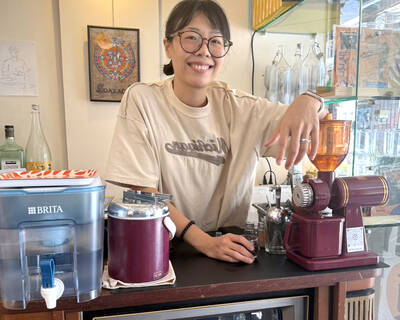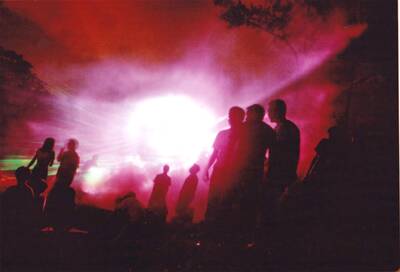To reach the only place in the world where cave paintings of prehistoric marine life have been found, archaeologists have to dive to the bottom of the Mediterranean off southern France.
Then they have to negotiate a 137-meter natural tunnel into the rock, passing through the mouth of the cave until they emerge into a huge cavern, much of it now submerged.
Three men died trying to discover this “underwater Lascaux” as rumors spread of a cave to match the one in southwestern France that completely changed the way we see our Stone Age ancestors.

Photo: AFP
Lascaux — which Picasso visited in 1940 — proved the urge to make art is as old as humanity itself.
Archaeologist Luc Vanrell’s life changed the second he surfaced inside the Cosquer cavern and saw its staggering images. Even now, 30 years on, he remembers the “aesthetic shock.”
But the cave and its treasures, some dating back more than 30,000 years, are in grave danger. Climate change and water and plastic pollution are threatening to wash away the art prehistoric men and women created over 15 millennia.

Photo: AFP
Since a sudden 12-centimeter rise in the sea level there in 2011, Vanrell and his colleagues have been in a race against time to record everything they can.
Every year the high water mark rises a few more millimeters, eating away a little more of the ancient paintings and carvings.
PREHISTORIC WONDERS
Vanrell and the diver-archaeologists he leads are having to work faster and faster to explore the last corners of the 2,500 square meter grotto to preserve a trace of its neolithic wonders before they are lost.
An almost life-sized recreation of the Cosquer cavern will open this week a few kilometers away in Marseille.
AFP joined the dive team earlier this year as they raced to finish the digital mapping for a 3D reconstruction of the cave. Around 600 signs, images and carvings — some of aquatic life never before seen in cave paintings — have been found on the walls of the immense cave 37 meters below the azure waters of the breathtaking Calanques inlets east of Marseille.
“We fantasied about bringing the cave to the surface,” said diver Bertrand Chazaly, who is in charge of the operation to digitalize the cave. “When it is finished, our virtual Cosquer cavern — which is accurate to within millimeters — will be indispensable for researchers and archaeologists who will not be able to physically get inside.”
CHILDREN’S HANDS
The cave was some “10 kilometers from the coast” when it was in use, said archaeologist Michel Olive. “At the time we were in the middle of an ice age and the sea was 135 meters lower” than it is today.
From the dive boat, Olive, who is in charge of studying the cave, draws with his finger a vast plain where the Mediterranean now is.
“The entrance to the cave was on a little promontory facing south over grassland protected by cliffs. It was an extremely good place for prehistoric man,” he said.
The walls of the cave show the coastal plain was teeming with wildlife — horses, deer, bison, ibex, prehistoric auroch cows, saiga antelopes but also seals, penguins, fish and a cat and a bear.
The 229 figures depicted on the walls cover 13 different species.
But neolithic men and women also left a mark of themselves on the walls, with 69 red or black hand prints as well as three left by mistake, including by children.
And that does not count the hundreds of geometric signs and the eight sexual depictions of male and female body parts.
What also stands out about the cave is the length of time it was occupied, said Vanrell, “from 33,000 to 18,500 years ago.”
The sheer density of its graphics puts “Cosquer among the four biggest cave art sites in the world alongside Lascaux, Altamira in Spain and Chauvet,” which is also in southern France.
“And because the cave walls that are today underwater were probably also once decorated, nothing else in Europe compares to its size,” he added.
Exploring Cosquer is also “addictive,” the 62-year-old insisted, with a twinkle in his eye. “Some people who have been working on the site get depressed if they haven’t been down in a while. They miss their favorite bison,” he smiled.
For Vanrell, diving down is like a “journey into oneself.” The spirit “of the place seeps into you.”

Cheng Ching-hsiang (鄭青祥) turned a small triangle of concrete jammed between two old shops into a cool little bar called 9dimension. In front of the shop, a steampunk-like structure was welded by himself to serve as a booth where he prepares cocktails. “Yancheng used to be just old people,” he says, “but now young people are coming and creating the New Yancheng.” Around the corner, Yu Hsiu-jao (饒毓琇), opened Tiny Cafe. True to its name, it is the size of a cupboard and serves cold-brewed coffee. “Small shops are so special and have personality,” she says, “people come to Yancheng to find such treasures.” She

The low voter turnout for the referendum on Aug. 23 shows that many Taiwanese are apathetic about nuclear energy, but there are long-term energy stakes involved that the public needs to grasp Taiwan faces an energy trilemma: soaring AI-driven demand, pressure to cut carbon and reliance on fragile fuel imports. But the nuclear referendum on Aug. 23 showed how little this registered with voters, many of whom neither see the long game nor grasp the stakes. Volunteer referendum worker Vivian Chen (陳薇安) put it bluntly: “I’ve seen many people asking what they’re voting for when they arrive to vote. They cast their vote without even doing any research.” Imagine Taiwanese voters invited to a poker table. The bet looked simple — yes or no — yet most never showed. More than two-thirds of those

In July of 1995, a group of local DJs began posting an event flyer around Taipei. It was cheaply photocopied and nearly all in English, with a hand-drawn map on the back and, on the front, a big red hand print alongside one prominent line of text, “Finally… THE PARTY.” The map led to a remote floodplain in Taipei County (now New Taipei City) just across the Tamsui River from Taipei. The organizers got permission from no one. They just drove up in a blue Taiwanese pickup truck, set up a generator, two speakers, two turntables and a mixer. They

Former Chinese Nationalist Party (KMT) chairwoman Hung Hsiu-chu’s (洪秀柱) attendance at the Chinese Communist Party’s (CPP) “Chinese People’s War of Resistance Against Japanese Aggression and the World Anti-Fascist War” parade in Beijing is infuriating, embarrassing and insulting to nearly everyone in Taiwan, and Taiwan’s friends and allies. She is also ripping off bandages and pouring salt into old wounds. In the process she managed to tie both the KMT and the Democratic Progressive Party (DPP) into uncomfortable knots. The KMT continues to honor their heroic fighters, who defended China against the invading Japanese Empire, which inflicted unimaginable horrors on the